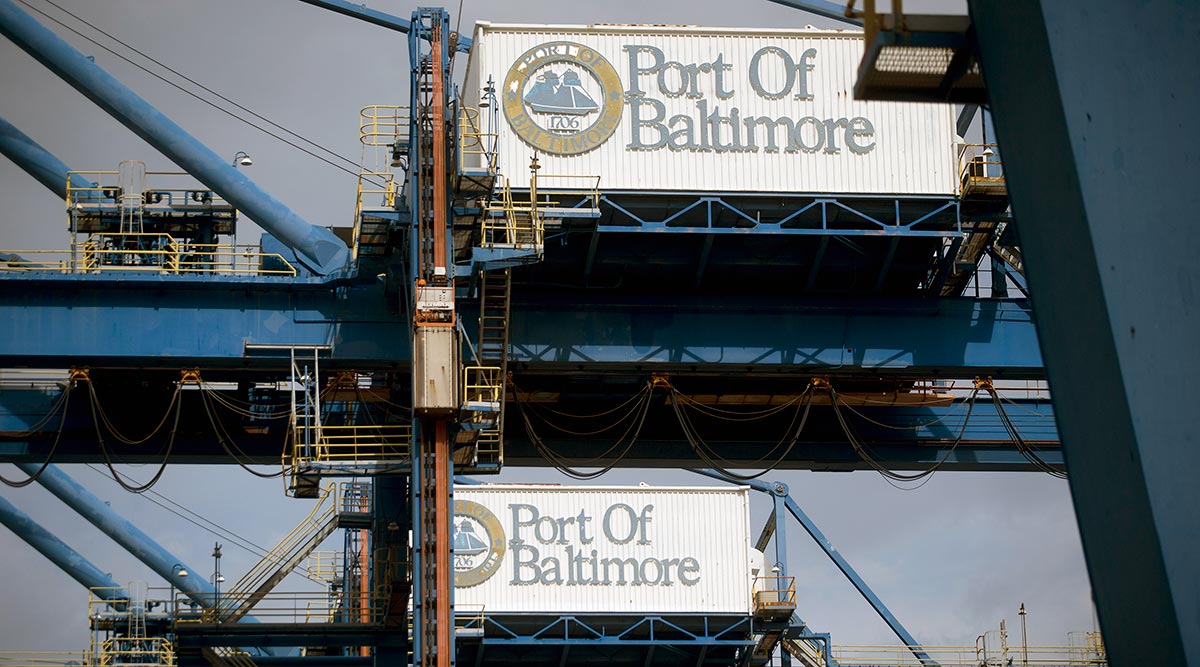Port of Baltimore's First Containership Through Expanded Panama Canal Carries Hope for Future

The arrival of the Ever Lambent, a massive green-hulled containership, in Baltimore on July 16 marks the end of a long wait and the beginning of what officials hope is a new era for the state-owned port.
The 1,095-foot Taiwanese cargo ship, which can carry 8,452 industry-standard 20-foot shipping containers, is the first of a new generation of massive containerships to call on the port after transiting the newly expanded Panama Canal, which opened late last month.
Over the past decade, Panama spent billions widening the canal, and East Coast ports spent hundreds of millions preparing to handle larger ships from Asia. The port of Baltimore already had deep enough channels and acquired four new giant cranes to unload the massive ships, so there's hope the new traffic coming through the Panama Canal will buoy its fortunes.
Baltimore stands to gain more than any other port on the East Coast, said James White, executive director of the Maryland Port Administration.
"I think the tide has turned for us in a positive way," White said.
While Baltimore is the nation's top port for automobiles, the tide of container traffic hasn't been particularly favorable in recent decades. It's recorded slow growth but lost market share to East Coast rivals that also serve the Mid-Atlantic and Midwest. Last year, New York handled the equivalent of 6.4 million 20-foot containers, and Norfolk moved more than 2.5 million, compared with Baltimore's approximately 800,000.
(Containers — truck-sized metal boxes that can be shifted between ships, trucks and trains — typically come in industry-standard 20- and 40-foot sizes, so they're measured in so-called 20-foot equivalent units.)
Still, the port has several advantages in the cutthroat competition for the larger ships that now will be coming at a faster clip through the larger canal.
In addition to its 50-foot channel and the new cranes at Seagirt Marine Terminal, Baltimore is consistently ranked among the nation's most efficient ports, and it is much less congested than busier ports such as New York. Including the Midwest, it serves the nation's third-largest group of consumers.
The port's location at the top of the Chesapeake Bay is perceived as a mixed blessing. While the East Coast's farthest inland port is that much closer to markets, ships must spend an extra eight hours to arrive, which means some shipping lines pass it by.
The port also remains hobbled by a bottleneck in its rail connections. While other ports can load trains with containers stacked two-high — the most efficient way for railroads, Baltimore cannot do so because the 120-year-old Howard Street Tunnel isn't tall enough. As a result, most containers shipped though the port serve customers within a day's drive by truck.
Earlier this month, the federal government turned down Maryland's request for $155 million to help the state and the railroad CSX, the tunnel's owner, expand it, opening up more distant destinations. The decision not to fund the project this year was "extremely excruciating and disappointing" for the port, White said.
"The decision didn't hurt us as far as jobs or economic impact," he said, "but it certainly didn't help us."
Despite the rail issue, Baltimore's location and inland infrastructure are among the best in the nation, said Walter Kemmsies, a managing director, economist and chief strategist at JLL Port, Airport & Global Infrastructure.
Getting containers into the port, he said, is generally less of a problem than the next step — moving them through to their destination either by truck or by train. Most U.S. freight moves by truck, and Baltimore's location near Interstate 95 and its less-congested roads present an opportunity for growth, Kemmsies said.
"As far as I can tell, Baltimore could do a lot more," he said.
The port administration projects the traffic through the larger canal will add 2 percentage points to the port's estimated 4% annual growth.
Evergreen Line doubled the capacity of the ships in its service between the Far East and the U.S. East Coast by deploying the Ever Lambent and others in its class, which carry twice as many containers as prior ships in the same trade, citing "the business opportunity presented by the expansion of the canal."
That service calls in Savannah, Georgia; Charleston, South Carolina; Baltimore and New York as it comes up the East Coast, before returning to Asia.
The global shipping industry has been increasing ship sizes for decades. Larger ships are simply more efficient. According to Evergreen, the Ever Lambent uses 40% less fuel than would two smaller ships needed to move the same number of containers.
The ships are growing ever more massive, too — the world's largest ship now can transport more than 20,000 containers and are too big to pass through even the expanded Panama Canal.
What's not yet clear is how those trends of growing volume and larger ships will play out at East Coast ports.
Brent Dibner, president of Dibner Maritime Associates, a maritime management consulting firm, said East Coast ports have duplicated each other's efforts to accommodate the larger ships, which could backfire in the long run.
"How many enormous ports does a nation need if we brought all the trade to the East Coast on a single gargantuan containership?" he mused. "I think this becomes the test for the survival of ports."

